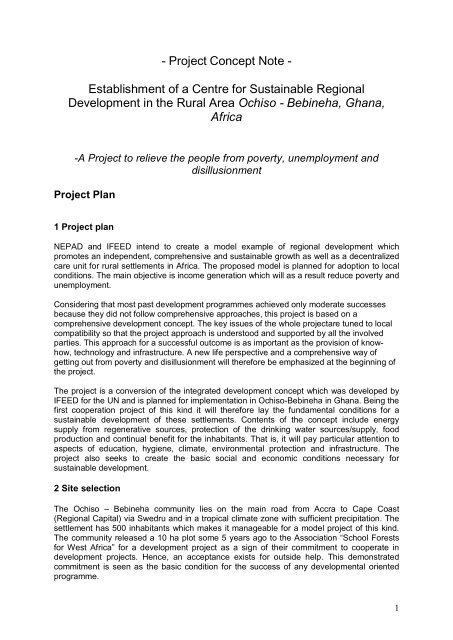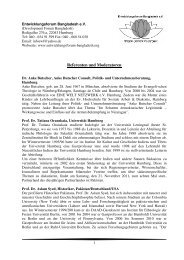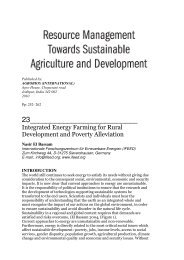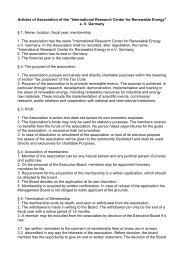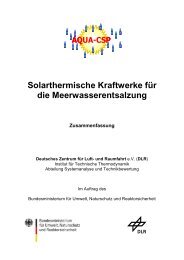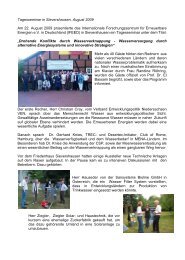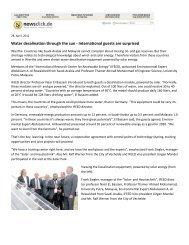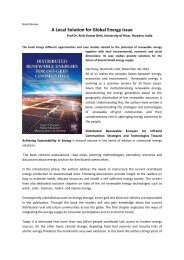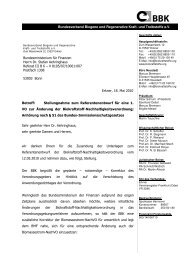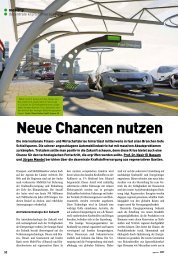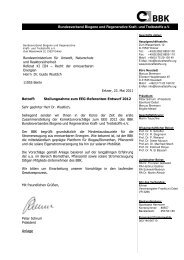Read the complete project concept note as PDF - IFEED
Read the complete project concept note as PDF - IFEED
Read the complete project concept note as PDF - IFEED
You also want an ePaper? Increase the reach of your titles
YUMPU automatically turns print PDFs into web optimized ePapers that Google loves.
- Project Concept Note -<br />
Establishment of a Centre for Sustainable Regional<br />
Development in <strong>the</strong> Rural Area Ochiso - Bebineha, Ghana,<br />
Africa<br />
-A Project to relieve <strong>the</strong> people from poverty, unemployment and<br />
disillusionment<br />
Project Plan<br />
1 Project plan<br />
NEPAD and <strong>IFEED</strong> intend to create a model example of regional development which<br />
promotes an independent, comprehensive and sustainable growth <strong>as</strong> well <strong>as</strong> a decentralized<br />
care unit for rural settlements in Africa. The proposed model is planned for adoption to local<br />
conditions. The main objective is income generation which will <strong>as</strong> a result reduce poverty and<br />
unemployment.<br />
Considering that most p<strong>as</strong>t development programmes achieved only moderate successes<br />
because <strong>the</strong>y did not follow comprehensive approaches, this <strong>project</strong> is b<strong>as</strong>ed on a<br />
comprehensive development <strong>concept</strong>. The key issues of <strong>the</strong> whole <strong>project</strong>are tuned to local<br />
compatibility so that <strong>the</strong> <strong>project</strong> approach is understood and supported by all <strong>the</strong> involved<br />
parties. This approach for a successful outcome is <strong>as</strong> important <strong>as</strong> <strong>the</strong> provision of knowhow,<br />
technology and infr<strong>as</strong>tructure. A new life perspective and a comprehensive way of<br />
getting out from poverty and disillusionment will <strong>the</strong>refore be emph<strong>as</strong>ized at <strong>the</strong> beginning of<br />
<strong>the</strong> <strong>project</strong>.<br />
The <strong>project</strong> is a conversion of <strong>the</strong> integrated development <strong>concept</strong> which w<strong>as</strong> developed by<br />
<strong>IFEED</strong> for <strong>the</strong> UN and is planned for implementation in Ochiso-Bebineha in Ghana. Being <strong>the</strong><br />
first cooperation <strong>project</strong> of this kind it will <strong>the</strong>refore lay <strong>the</strong> fundamental conditions for a<br />
sustainable development of <strong>the</strong>se settlements. Contents of <strong>the</strong> <strong>concept</strong> include energy<br />
supply from regenerative sources, protection of <strong>the</strong> drinking water sources/supply, food<br />
production and continual benefit for <strong>the</strong> inhabitants. That is, it will pay particular attention to<br />
<strong>as</strong>pects of education, hygiene, climate, environmental protection and infr<strong>as</strong>tructure. The<br />
<strong>project</strong> also seeks to create <strong>the</strong> b<strong>as</strong>ic social and economic conditions necessary for<br />
sustainable development.<br />
2 Site selection<br />
The Ochiso – Bebineha community lies on <strong>the</strong> main road from Accra to Cape Co<strong>as</strong>t<br />
(Regional Capital) via Swedru and in a tropical climate zone with sufficient precipitation. The<br />
settlement h<strong>as</strong> 500 inhabitants which makes it manageable for a model <strong>project</strong> of this kind.<br />
The community rele<strong>as</strong>ed a 10 ha plot some 5 years ago to <strong>the</strong> Association “School Forests<br />
for West Africa” for a development <strong>project</strong> <strong>as</strong> a sign of <strong>the</strong>ir commitment to cooperate in<br />
development <strong>project</strong>s. Hence, an acceptance exists for outside help. This demonstrated<br />
commitment is seen <strong>as</strong> <strong>the</strong> b<strong>as</strong>ic condition for <strong>the</strong> success of any developmental oriented<br />
programme.<br />
1
3 Project Procedure<br />
The regional development is planned to commence on <strong>the</strong> aforementioned 10 hectares plot<br />
of land. A centre is to be started here (analogue of a model settlement) which is independent<br />
of any central care service. It is to serve <strong>as</strong> a demonstration and teaching destination to be<br />
linked with tourist facilities in <strong>the</strong> Region like “Kaum Nature Park” near <strong>the</strong> Regional Capital,<br />
Cape Co<strong>as</strong>t, which attracts 170 000 tourists a year. The settlement Ochiso – Bebineha will<br />
not be influenced directly by <strong>the</strong> <strong>project</strong>.<br />
Advantages<br />
1. Project follows a comprehensive development approach. The foundations of <strong>the</strong><br />
development approach are tuned to local compatibility.<br />
2. The centre itself can grow gradually and adapt itself to changing circumstances and<br />
<strong>the</strong> respective needs and wishes of <strong>the</strong> inhabitants in <strong>the</strong> region.<br />
3. No structures will be forced on <strong>the</strong> population, but an example of an adapted<br />
sustainable and regional development will be presented by which <strong>the</strong> population will<br />
integrate at <strong>the</strong>ir own discretion on a step by step b<strong>as</strong>is.<br />
4. The inhabitants are to be included in <strong>the</strong> working and decision making processes. In so<br />
doing, <strong>the</strong>y will acquire <strong>the</strong> capacity to generate income and improvement of <strong>the</strong>ir life<br />
situation. (Learning by doing)<br />
5. During <strong>the</strong> time frame of <strong>the</strong> <strong>project</strong>, <strong>the</strong>re will be a smooth transition from <strong>the</strong><br />
"demonstration operation" to <strong>the</strong> planned regional settlement development.<br />
6. The <strong>project</strong> can be extended to all are<strong>as</strong> of life, production and free time<br />
4 Project ph<strong>as</strong>es<br />
Ph<strong>as</strong>e 1: Elaboration of <strong>the</strong> <strong>project</strong> plan<br />
- Self organization of <strong>the</strong> <strong>project</strong> team into working groups.<br />
- Preparation of a <strong>project</strong> plan on <strong>the</strong> b<strong>as</strong>is of <strong>the</strong> accumulated data by <strong>the</strong> working groups<br />
(input of <strong>the</strong> Applicant).<br />
Ph<strong>as</strong>e 2: Planning (fe<strong>as</strong>ibility study)<br />
- Dispatch an exploratory and field research team to Ochiso – Bebineha.<br />
- Detailed planning of <strong>the</strong> individual development stages <strong>as</strong> a result of surveys, enquiries,<br />
investigations and negotiations conducted on-site with <strong>the</strong> inhabitants and responsible<br />
authorities.<br />
- Determination of demand for <strong>the</strong> necessary structures, equipment and <strong>the</strong> technical<br />
know-how in <strong>the</strong> region, in <strong>the</strong> country and abroad.<br />
- Development of cost and finance plan.<br />
- Formulation of a chronologically solidly built developed plan.<br />
Ph<strong>as</strong>e 3: Implementation of <strong>the</strong> Project<br />
The establishment of <strong>the</strong> <strong>project</strong> will begin after completion of a detailed development plan<br />
prepared from <strong>the</strong> outcome of Ph<strong>as</strong>e 2.<br />
2
5. Project partners<br />
NEPAD http://www.nepad.org/<br />
NEPAD, „New Partnership for Africa's Development “is an African initiative m<strong>as</strong>terminded in<br />
2001 by presidents of Nigeria, South Africa, Algeria and Senegal. It is considered by <strong>the</strong> G8<br />
states <strong>as</strong> <strong>the</strong> most important development initiative for Africa. The objects are challenging:<br />
elimination of poverty, sustainable growth, <strong>the</strong> development of infr<strong>as</strong>tructure on <strong>the</strong> continent,<br />
integration of Africa in <strong>the</strong> global economy and <strong>the</strong> streng<strong>the</strong>ning of all social groups,<br />
especially of women.<br />
<strong>IFEED</strong> http://ifeed.org<br />
The International Research Centre for Renewable Energies e. V. Germany (<strong>IFEED</strong>) w<strong>as</strong><br />
founded in 1999 and serves in supporting renewable energies and <strong>the</strong> implementation of<br />
new developments in this area. The t<strong>as</strong>ks of <strong>the</strong> centre include research, demonstration <strong>as</strong><br />
well <strong>as</strong> consultancy and education. Major t<strong>as</strong>ks are <strong>the</strong> integrated use of all renewable<br />
energy resources available at a location, especially in rural are<strong>as</strong>, <strong>the</strong> development of an<br />
energy supply and utilization management <strong>as</strong> well <strong>as</strong> <strong>the</strong> improvement of <strong>the</strong> socio-<br />
economic structures in developing countries.<br />
Schulwälder für Westafrika e.V. http://www.schulwaelder.org/<br />
School Forests for West Africa e. V. w<strong>as</strong> founded in 2000 in Goettingen and is <strong>the</strong> contact<br />
organization between <strong>the</strong> networks in <strong>the</strong> West of Africa (Youth and Environmental club,<br />
schools in Ghana) and <strong>the</strong> networks in Germany (Schools Children forest <strong>project</strong>, German<br />
Development Agency (DED regional educational Station). The Association h<strong>as</strong> long-standing<br />
experiences in <strong>the</strong> area of <strong>the</strong> North-south school partnerships and with partnerships<br />
between German and Ghanaian schools. It works toge<strong>the</strong>r with a partner <strong>as</strong>sociation in<br />
Ghana „ Youth and Environmental club “on <strong>the</strong> implementation of common <strong>project</strong>s. In 2002<br />
<strong>the</strong> <strong>as</strong>sociation in Germany acquired a property of 10-ha plot of land in Ochiso (Ghana) for<br />
its Ghanaian partner <strong>as</strong>sociation for <strong>the</strong> establishment of an environmental centre.<br />
Youth and Environmental Club<br />
Youth and Environmental club (youth – environment – club): w<strong>as</strong> founded in 1998 in Ghana.<br />
The non-governmental organization (NGO) h<strong>as</strong> proved its worth during <strong>the</strong> p<strong>as</strong>t years by <strong>the</strong><br />
Initiation of tree planting on school compounds. The number of schools involved in <strong>the</strong><br />
<strong>project</strong> incre<strong>as</strong>ed from 4 in 1998 to 72 in 2006.<br />
The <strong>as</strong>sociation is ready, in collaboration with its partner <strong>as</strong>sociation “School Forests for<br />
West Africa e. V.” to be involved in establishing an environmental centre in Ochiso after <strong>the</strong><br />
principles of <strong>the</strong> education for a sustainable development for Ghanaian schools.<br />
3
6. Information on Ochiso – Bebinaha, Ghana<br />
6.1. B<strong>as</strong>ic Information about Ghana:<br />
Republic: Ghana /Republic of Ghana<br />
Motto: Freedom and Justice<br />
Official languages: English<br />
Capital: Accra<br />
Demonym Ghanaian<br />
Form of Government: Presidential (Constitutional) Republic<br />
President (current): John Agyekum Kufuor<br />
Area: 238.537 km²<br />
Population: 22.409.572 (extrapolation, or estimated 2006)<br />
Population density: 94 inhabitants / km²<br />
BIP/Capita: 95 US-$ (2005), (Per capita US-$ 2,750)<br />
Currency: 1 New Cedi = 100 Pesewa, (Ghanaian cedi - GHS<br />
Independence: 6. March 1957<br />
National An<strong>the</strong>m: God Bless Our Homeland Ghana<br />
Time zone: GMT (UTC)<br />
Internet-TLD: GH<br />
Calling code: +233<br />
Mortality (death) rate 13 /1000 Inhabitants<br />
Natarity (birth-rate) 31/1000 Inhabitants<br />
Fertility rate pro woman 4.4<br />
Infant mortality 95/1000 Inhabitants<br />
Baby mortality 59/1000 Iife births<br />
Population growth 1.8%<br />
Urban population 37%<br />
Population under 15 years 41.9%<br />
Population over 65 years 4.4%<br />
6.2 Information about <strong>the</strong> Settlement area<br />
Location of Project: Project-Village-Name: Bebineha<br />
District: Ochiso<br />
Region in Ghana: Central,<br />
Regional Capital: Cape co<strong>as</strong>t<br />
District: Ajumako/Enyan/Essiam<br />
District Capital: Ajumako<br />
Population-figure: 500, Density: 30 -40 people / House, ca. 50 Households<br />
Age structure: 45% children, 30% youth, 25% adult .<br />
Re<strong>as</strong>ons: Migration of <strong>the</strong> youth<br />
Gender ratio: Men: Women: 40: 60<br />
Religion: 55 % Christian, 25% Moslem, 20 % various denominations<br />
including natural religions<br />
Education: The level of education is very low. There are no schools in <strong>the</strong><br />
area. This makes school attendance among <strong>the</strong> children very<br />
irregular.<br />
4
Employment: Subsistent farming. Trade with farming products which exceed<br />
<strong>the</strong>ir own needs. Handwork: Local soap making<br />
Mode of employment: Self employed: Pe<strong>as</strong>ant farmers and traders<br />
Energy source and No electricity; Light: only Kerosene; Cooking: exclusively firewood<br />
and consumption<br />
Security system: Stable and effective, “Each one for one ano<strong>the</strong>r”<br />
Administration: Bebineha is under an Administrative council in <strong>the</strong> District capital,<br />
Ajumako which is about 15 Km away. It is also responsible for <strong>the</strong><br />
security. In practice, <strong>the</strong> Headman (chief) administers <strong>the</strong> village with a<br />
traditional council comprised of a representative from each of <strong>the</strong> 7<br />
clans in <strong>the</strong> village<br />
Provision: Self supply with staple foods, fuel, oil and o<strong>the</strong>r (very economical)<br />
materials which are additionally bought.<br />
Water: Although a water pipeline runs through <strong>the</strong> village to Ochiso, <strong>the</strong> nearby small<br />
town, <strong>the</strong> inhabitants have no access to treated drinking water<br />
since <strong>the</strong>y cannot afford to pay. They ei<strong>the</strong>r fetch water from a small<br />
stream nearby or from <strong>the</strong> Ochiso river which is 3 km away.<br />
Domestic sewage: No sewage system, pit latrine<br />
Health care: Travel 6 km to nearby health post, Notification by a running messenger.<br />
Traditional medicine<br />
Modern Communication: None<br />
Food nourishment: Self supply, mainly starchy food (diet not balanced)<br />
Soil: Sandy loam, lower humus content, soil erosion<br />
Climate: tropical, warm, enough precipitation<br />
Economic plants: Oil palm, Citrus fruits (Oranges), Coconut, Avocado, Pineapple, Guava,<br />
Manioc, Banana, Plantain, Maize, Rice, Sugar cane, Papaya, Sweet<br />
potatoes<br />
Vegetables: Onion, Tomatoes, Aubergine, Beans, Carrots, Ocro, Spinach<br />
Spice plants: Pepper, Vanilla, etc.<br />
Products: Major: Cacao bean<br />
Minor: Soap making, Gari (c<strong>as</strong>sava), Hand work<br />
Technology: None<br />
Animal husbandry: Small Ruminants (goats and sheep), cows, pigs, local poultry<br />
5
Forestry: No sustainable forest enterprise, forest is converted into farmland<br />
Existing Tree species:<br />
Mahagony spp. like Azobi, Sapeli and Okume, Palisander, Khaya;<br />
Teak, Abachi, Okume, Afrormosia, Oil palm<br />
Wood utilization: Personal requirement for fire- and construction lumber; trees on<br />
farm lands are sold cheaply to timber dealers; charcoal production<br />
Income: under 1 $ per day/person<br />
Health care: Contaminated water and lack of general sanitation contributes to<br />
infectious dise<strong>as</strong>es.<br />
AIDS, which is a problem in urban are<strong>as</strong>, is insignificant here.<br />
Fire wood utilization: Formerly only dried dead wood w<strong>as</strong> used; this is virtually not available<br />
anymore and collecting distance h<strong>as</strong> incre<strong>as</strong>ed significantly, <strong>the</strong>refore<br />
felling follows (fits in wood utilization above)<br />
6


